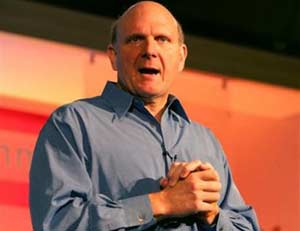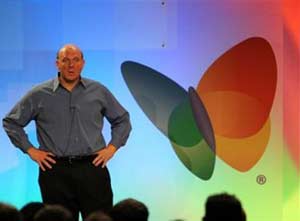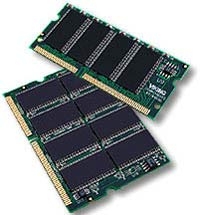The software giant acquires an advertising company, pouring unprecedented amounts of money into Xbox and Web services… No one knows what secret “scheme” Microsoft is plotting.
 |
|
Steve Ballmer, CEO of Microsoft, believes the company has made “remarkable progress” in online search and advertising over the past two years. Source: AP |
Just as Microsoft investors began to “digest” the company’s sluggish growth and expansion, they were hit with a series of shocks. First came the financial results that aligned with expectations, followed by an extraordinarily bold and generous budget plan.
Too Many Goals
In the 2007 fiscal year, under CEO Steve Ballmer, Microsoft will invest $2 billion more than Wall Street had predicted. “We have decided to invest heavily in several areas,” said CFO Chris Liddell.
The areas Mr. Liddell referred to include: 1. increasing production of the Xbox 360 gaming console; 2. pouring more funds into the nascent Windows Live service to provide software applications via the Web; and 3. continuing to acquire other companies.
While the intentions are clear, many investors are still scratching their heads, wondering why and how Microsoft’s additional investments could be so excessive. “It’s as if they are building a Google or Yahoo from within!” exclaimed analyst Rick Sherlund of Goldman Sachs & Co.
First, there’s MSN
Yesterday, Microsoft CEO Steve Ballmer detailed the budget expansion plan to boost the Internet services business.
An astonishing $1.1 billion will be allocated to MSN in the upcoming fiscal year, primarily for research and development, leaving investors stunned. This represents a significant jump from the $700 million planned for this year and $500 million from last year. Moreover, MSN plans to allocate up to $500 million as capital expenditures in fiscal year 2007, a fivefold increase compared to 2005.
“We have told our R&D (Research and Development) staff that Web services are our top priority,” Ballmer stated. He promised that Microsoft would spend aggressively, matching any major player in the advertising sector. “I believe only (at best) two or three companies can provide a robust enough infrastructure to compete,” Ballmer confidently asserted.
Too Quiet on Explanations
CFO Liddell insisted that Microsoft was not hiding anything with this unusual investment plan, but investors were not satisfied with that answer. Microsoft’s stock price dropped by 6.3%, closing at $25.57 at the end of trading.
Analysts were frustrated by the severe lack of information. “Where is the money going? No one knows the answer,” another analyst remarked. “It’s as if the money has all fallen into a black hole.”
What lies behind this angry reaction? At least part of the reason is that analysts and investors have long viewed Microsoft as a “value ladder” rather than a source of earnings from stocks. Because of this, they prefer slow growth over erratic stock increases.
Recently, the growth of Windows sales has been somewhat sluggish, primarily because most of Windows’ revenue comes from computer manufacturers who purchase the operating system at wholesale prices and in large quantities.
Massive Acquisition
Another expected move from Microsoft was the acquisition of Massive Inc., a company specializing in integrating advertisements into video games. Naturally, Microsoft will reuse Massive’s technology in its other online products.
Microsoft’s practice of acquiring smaller companies rather than investing from scratch in new business divisions is not new in the tech world. This time, the goal is nothing less than to revitalize its online advertising division and increase competitiveness against Google.
Speaking of Massive, advertising has long been present in video games, but mostly in the form of static ads. Once embedded in a game, these ads remain unchanged.
However, Massive’s technology allows advertisers to insert entirely new ads into games and consoles through internet connectivity. In games that integrate Massive’s technology, advertisers can change ad content at will: one day promoting an upcoming movie, and the next advertising a new soda. Furthermore, they can tailor ads according to different geographic regions.
In its announcement, Microsoft stated that it hopes to integrate these features into its existing products, most urgently into MSN online. Undoubtedly, Massive’s technology will also be part of Microsoft’s upcoming AdCenter advertising tool.
The Ace Up the Sleeve: AdCenter
 |
|
Steve Ballmer next to the MSN logo. Source: AP |
Recently, Microsoft unveiled AdCenter, a tool that the company is currently using for 100% of its search advertising contracts in the United States. Previously, Microsoft relied on Yahoo’s paid search technology, and in fact, Yahoo’s search engine is still being utilized by Microsoft in many international markets.
Yesterday, the Wall Street Journal reported a somewhat “shocking” piece of news: several officials within Microsoft want the software giant to acquire Yahoo’s shares and collaborate to combat Google.
Commenting on this article, Ballmer stated that the relationship between Microsoft and Yahoo has been complex over the years—both cooperative and competitive, “both friends and foes.” However, he remained tight-lipped about the scenario painted by the Wall Street Journal.
Yusuf Mehdi, Microsoft’s senior vice president responsible for advertising strategy, also announced the future version of AdCenter, which could handle both contextual advertising and paid search. Mehdi indicated that Microsoft plans to test a limited version of the contextual advertising tool this summer.
Additionally, Mehdi introduced two projects from Microsoft Research, where over 50 of the company’s experts are diligently researching new advertising technologies. One project aims to predict users’ demographic parameters based on the context of a website. The other project seeks to address users’ tendency to fast-forward through ads by introducing mini ads of five seconds. Whenever the main ad is skipped, the mini ad will pop up, leaving users with no escape.
Search Remains the Top Priority
Two years after admitting Microsoft’s failure to develop its own search engine, Steve Ballmer proudly declared that the giant has made significant “progress” in its battle against Google and Yahoo.
In a relatively short time, Microsoft has achieved impressive milestones in two key areas: creating a search engine and establishing its own online advertising platform. However, Ballmer also acknowledged that there is still much work to be done at Microsoft and that “If only Microsoft had started earlier.”
More than anyone, Microsoft understands the cost of being a “slow-moving ox drinking muddy water.” Until recently, the company had only begun to use its own technology in 100% of its search contracts in the U.S., and its market share is significantly smaller compared to both Google and Yahoo (Google 49%, Yahoo 22.5%, while MSN holds 11%).
Even Bill Gates, the chairman, had to concede that Google has “done a remarkable and outstanding job” in building its search engine and web advertising platform. Nevertheless, Gates still tried to salvage the situation by stating that Microsoft’s efforts are “not any less strong.” – “I think this is one of the rare occasions where we are somewhat underestimated,” Gates remarked.
Big Ambitions
 |
| Source: AFP |
Attracting more users to utilize its search engine, thereby drawing in more advertising revenue, is the path that Microsoft can pursue successfully with its new online advertising platform, AdCenter. However, Ballmer stated that the search engine is just “a small part” of the overall strategy.
The real ambition of the software giant is to enable advertisers across… all Microsoft products, from television to online gaming. This is why Ballmer believes that if they can draw more users to the MSN portal, their email service, and instant messaging (IM), the success would be truly significant.
It can be said that the fastest-growing and most fiercely competitive area right now is the web services sector, where applications like email, photo sharing, and productivity suites like Office can be accessed online.
While Google has achieved remarkable success in this field, Microsoft has primarily continued to release software via traditional CD formats. Nevertheless, Ballmer remains optimistic, asserting that Microsoft is not falling behind its competitors, as they possess high technological standards and a loyal customer base.
The remaining challenge is how Ballmer can convince investors to share his optimism.
Thiên Ý (Compiled from CNET, BusinessWeek, AP, AFP, Reuters)





















































